LA Galbi (Korean BBQ Short Ribs)
Juicy Korean BBQ short ribs (LA Galbi) you can make at home! Thin flanken-cut beef ribs get a two-step marination with fruits and soy-garlic sauce for deep, sweet-savory flavor, then grill or broil to perfection — perfect for weeknight dinners or backyard BBQs.

I first tried LA-style galbi about three decades ago in San Francisco — if my memory’s right, my friend took me to this nice Korean restaurant where the ribs came out sizzling and fragrant. I was immediately intrigued.
The galbi looked completely different from what I’d eaten all my life — thinner, cut straight across the bone instead of the usual long Korean short rib cut. One bite of that sweet, smoky beef and I knew this version had its own charm.
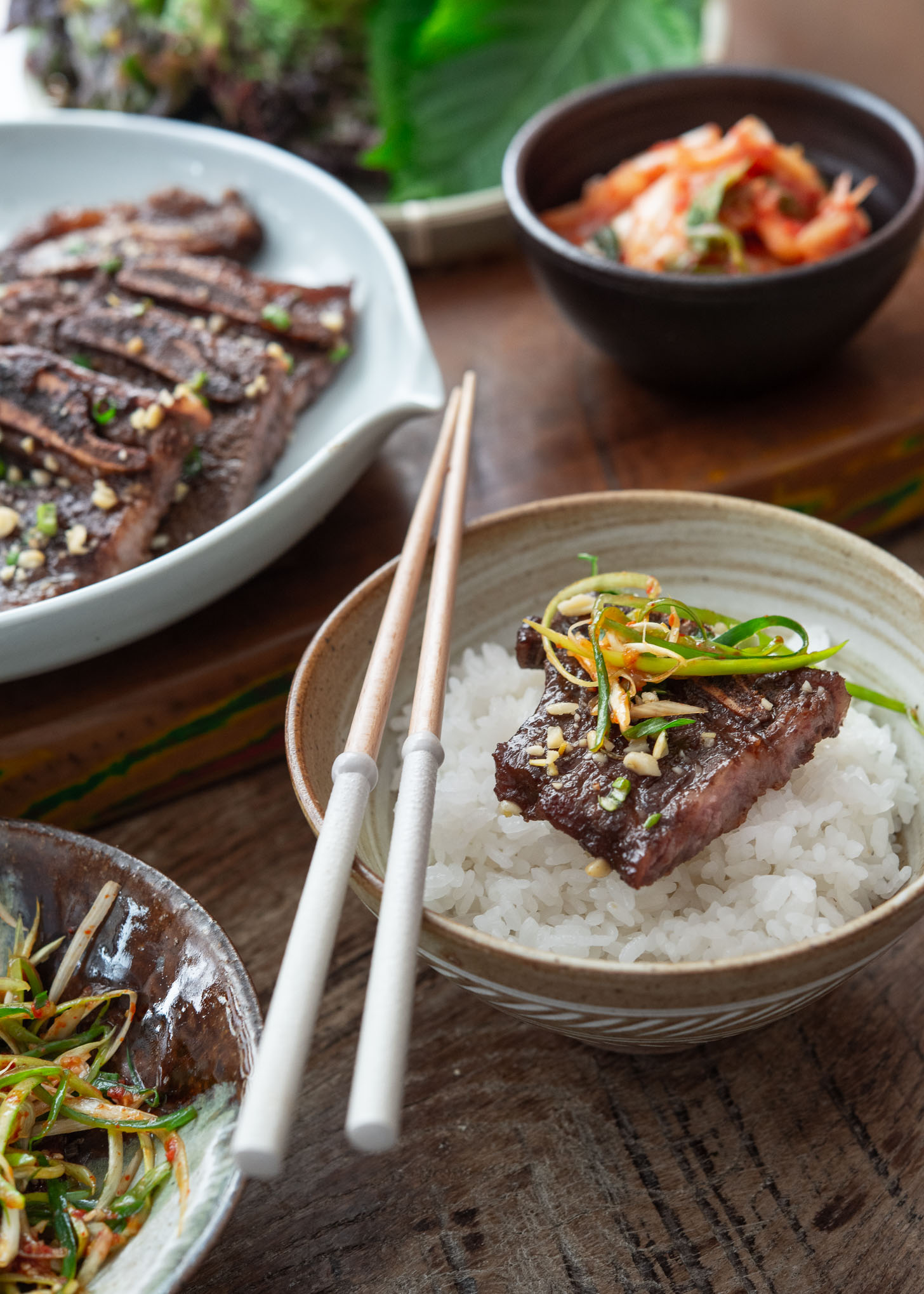
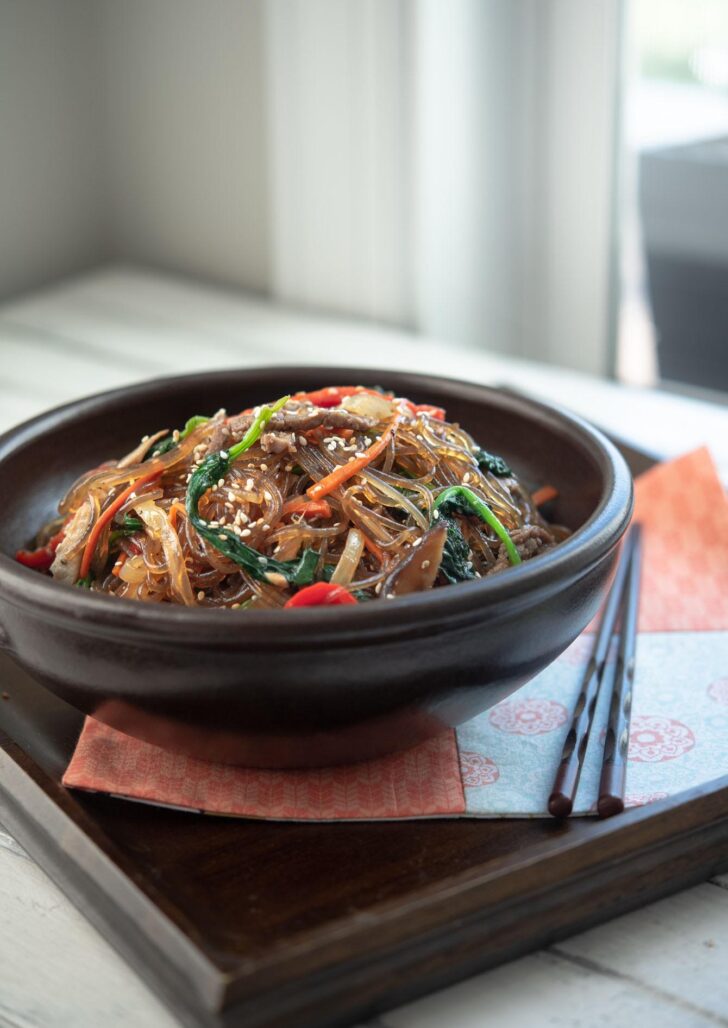
Get new recipes via email:
LA galbi was born from Korean immigrants in Los Angeles who adapted to the American flanken-cut style, and honestly, I thank them every grilling season. The thinner cut soaks up marinade beautifully and cooks fast, perfect for impatient BBQ lovers like me.
The two-step marination I use here was a tip from a Korean friend who once took cooking classes with a well-known master chef in Seoul. She shared what she learned, and it completely changed how I make galbi. The rest is simple — two rounds of marinating that make the ribs extra tender and full of flavor. I’ll show you exactly how it works below.
Whether you’re grilling outdoors, broiling in the oven, or cooking indoors on a chilly day, these short ribs turn out succulent, caramelized, and seriously hard to stop eating. Once you try it, I think you’ll see why it’s been my go-to for years.
If you love Korean short rib dishes, you might also enjoy my Galbi Jjim (Korean Braised Short Ribs) and Galbitang (Beef Short Rib Soup) — both comforting and full of rich, deep flavor.
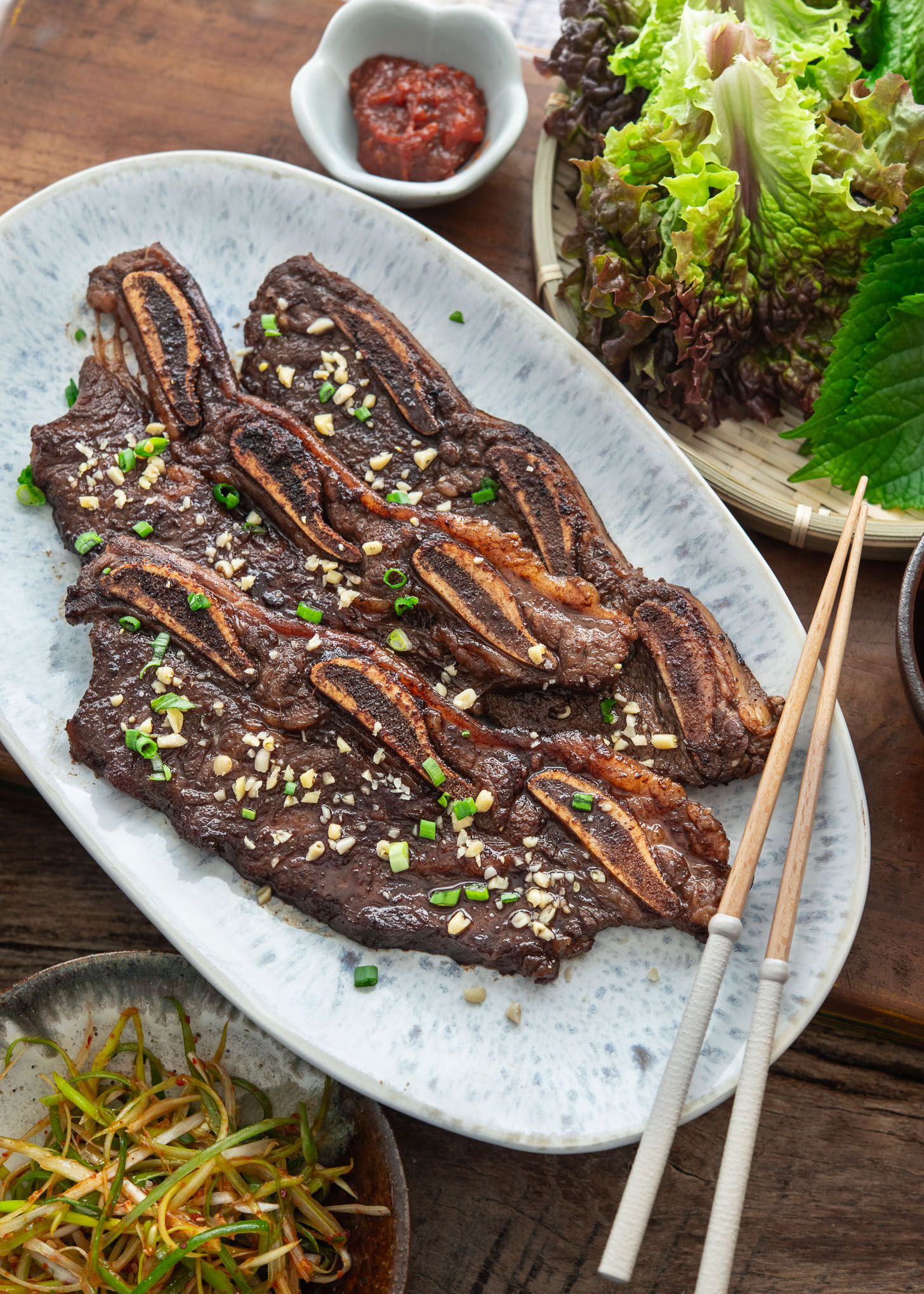
Why This LA Galbi Recipe Is the Best
If you’ve made galbi before, you already know the marinade can make or break it. The secret here is not just what’s in the sauce, but how it’s layered. My two-step marination method builds flavor in stages — tender first, then tasty.
The first round softens the meat so it stays juicy even after grilling, and the second brings that deep, sweet-savory glaze you expect from a great Korean BBQ rib. The difference is huge — you get meat that’s melt-in-your-mouth tender inside and beautifully caramelized outside.
I’ve tested this recipe more times than I can count, adjusting the timing and balance until it nailed that classic LA galbi flavor — sweet, garlicky, and a little smoky. Every batch disappears fast. Even my family, who’s eaten galbi all their lives, still says this one tastes straight out of a Korean BBQ restaurant.
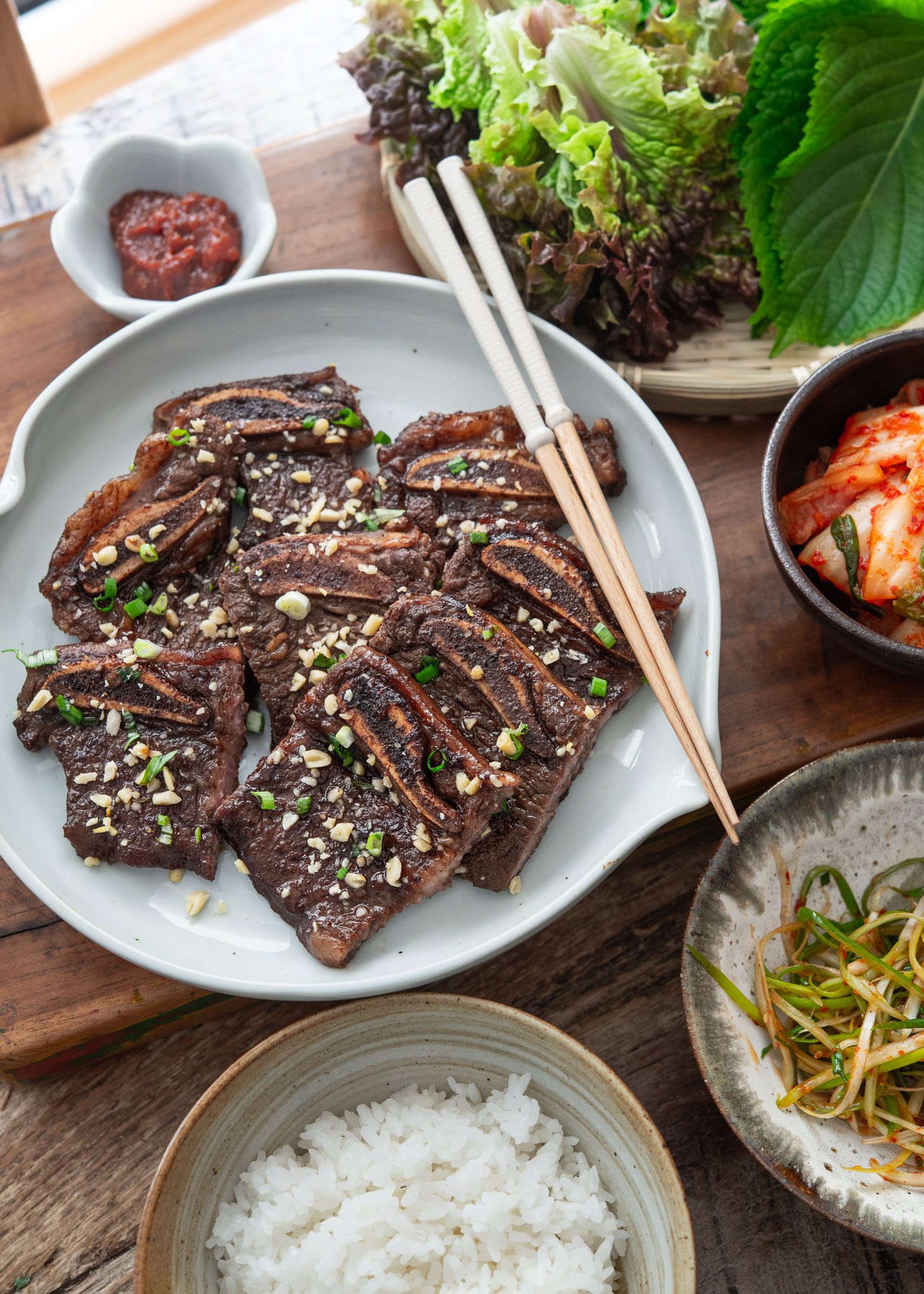
Choosing the Right Short Ribs for LA Galbi

The secret to unforgettable galbi starts with good beef. The flanken-style cut (what we call LA galbi) is sliced thin across the bone — usually three small bone sections per slice. This style lets the marinade soak in fast and gives you that caramelized surface after grilling.
Look for well-marbled short ribs with even thickness — around ⅜-inch is ideal. Any thicker than ½-inch, and they won’t cook evenly. Korean or Asian grocery stores often sell pre-cut LA galbi ribs, but you can also ask a local butcher to slice English-cut ribs across the bone, about 3 ribs per slice.
How to Make the Best Marinade (Two-Step Method)
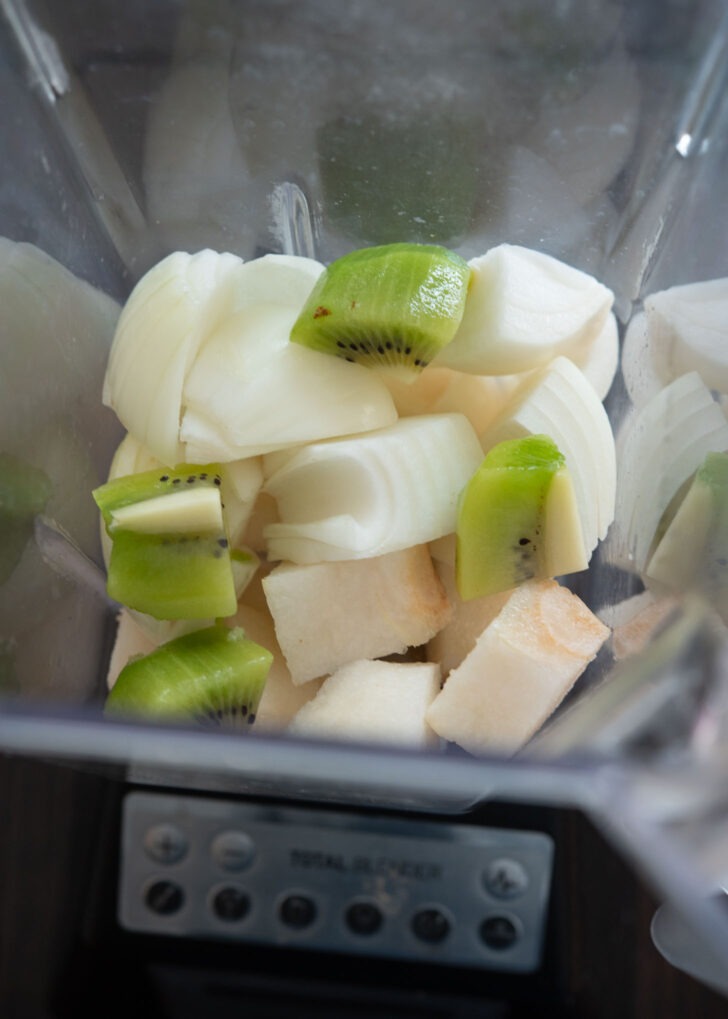
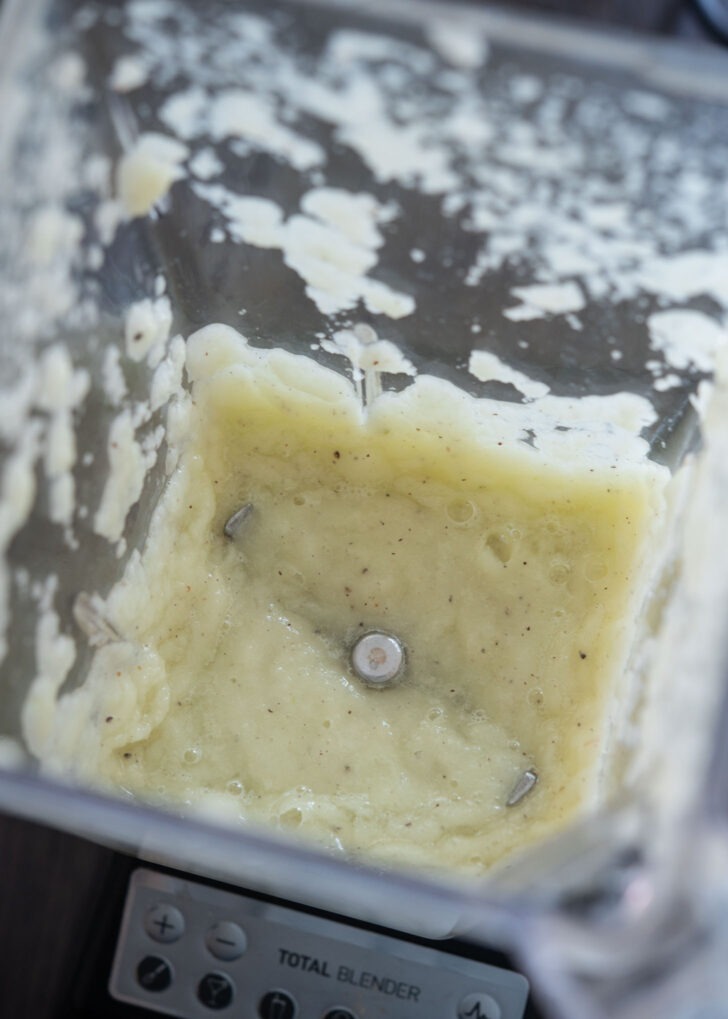
Step 1. Tenderize: Blend onion, pear, and kiwi (or use a fine grater) to make a smooth puree. This mixture gently breaks down the beef fibers and adds a natural sweetness.
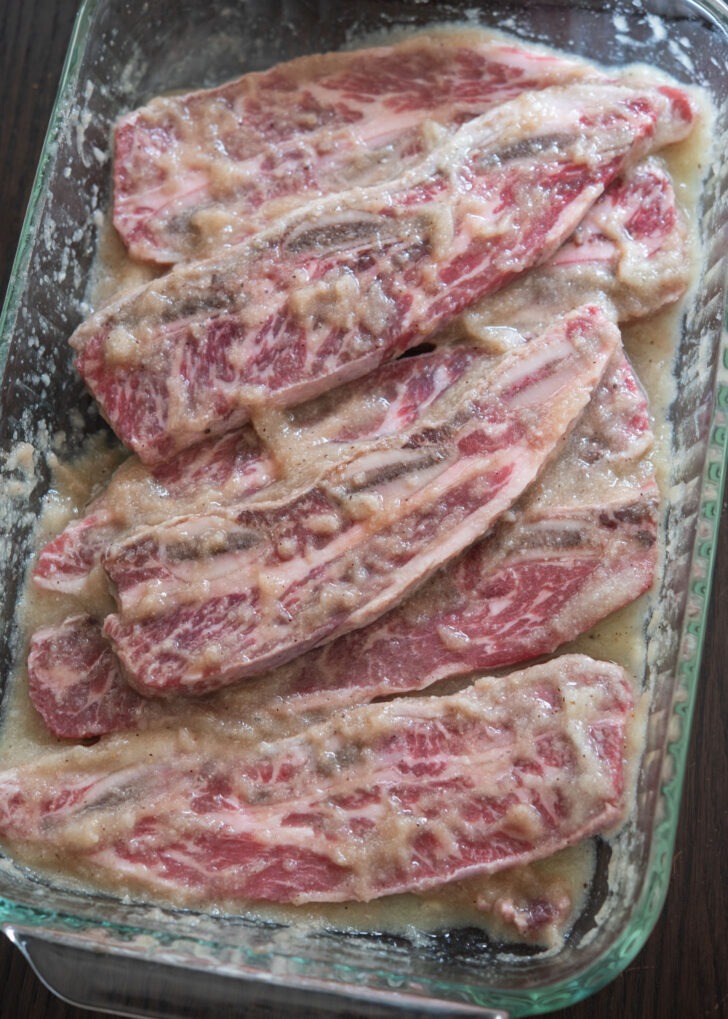
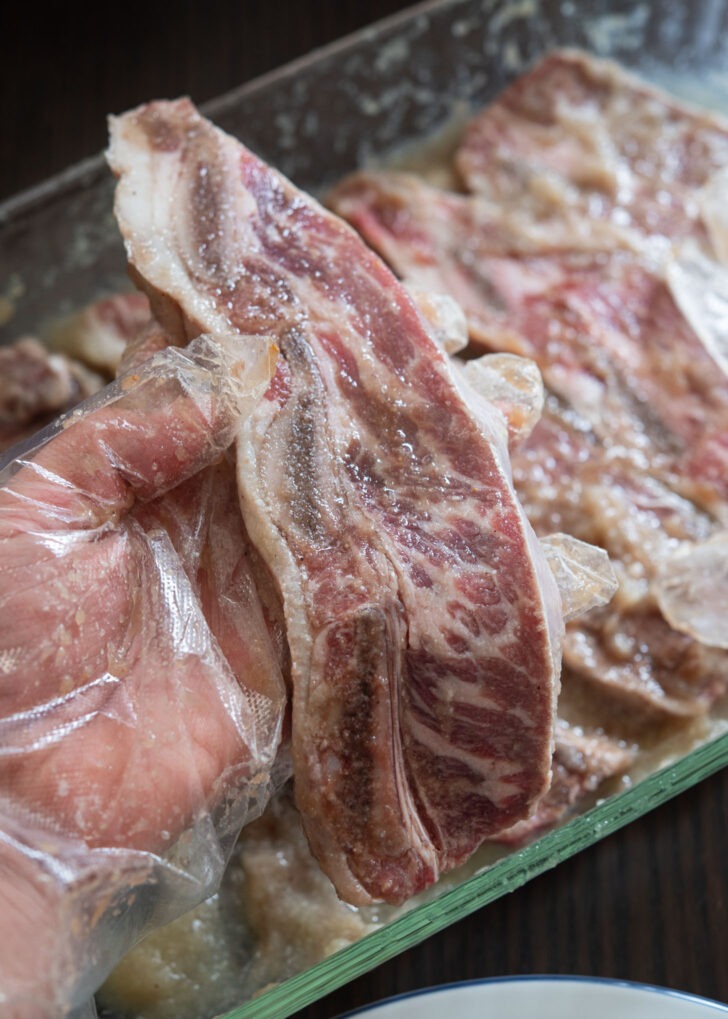
Step 2. Marinade: Coat the ribs and let them rest for about 45 minutes at room temperature or 2 hours in the fridge. Scrape off the excess before moving on.
Common Mistake: Over-marinating with fruit puree. It can make the surface mushy — scrape it off before grilling for better browning.
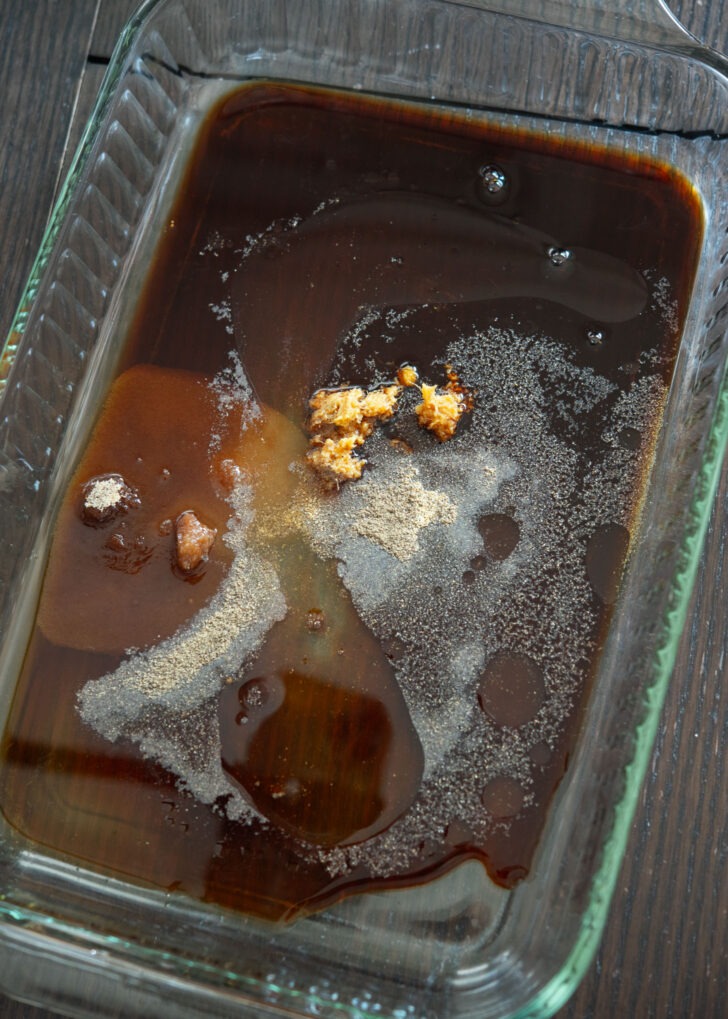
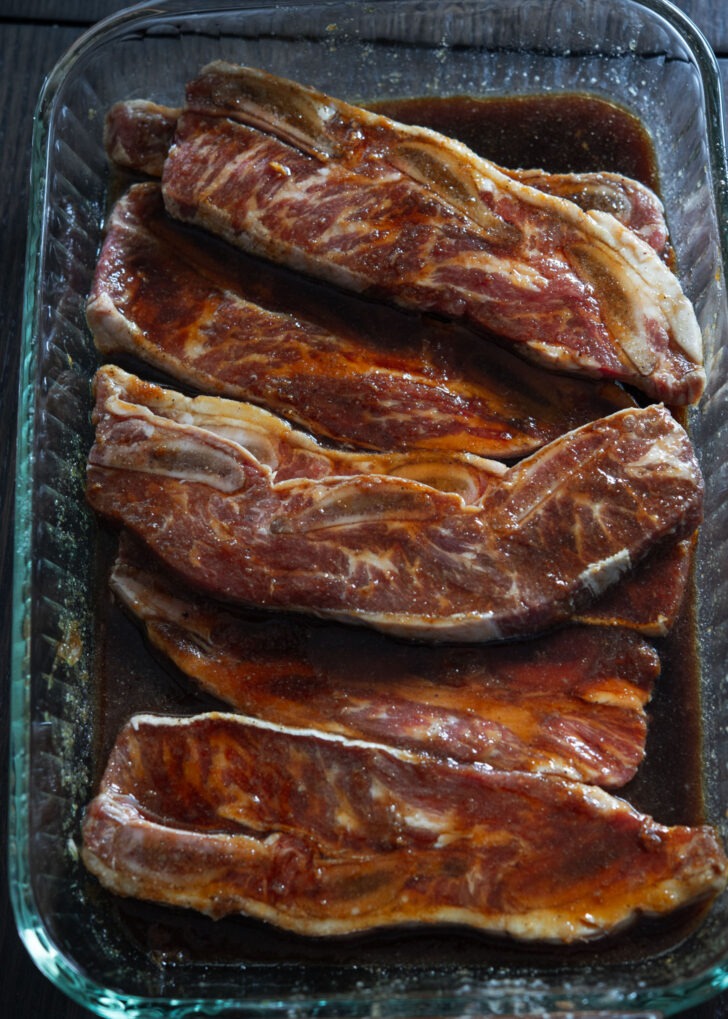
Step 3. Flavor: Mix soy sauce, soup soy sauce, brown sugar, garlic, sesame oil, ginger, and black pepper. Massage this marinade into the ribs and chill at least 4 hours or overnight. Let them sit at room temperature before cooking. The result? Deep, layered flavor without losing tenderness.
How to Cook LA Galbi: Grill, Broil, or Pan-Sear
LA galbi cooks fast — that thin flanken cut means just a few minutes per side. No matter how you cook it, the key is high heat and a watchful eye.
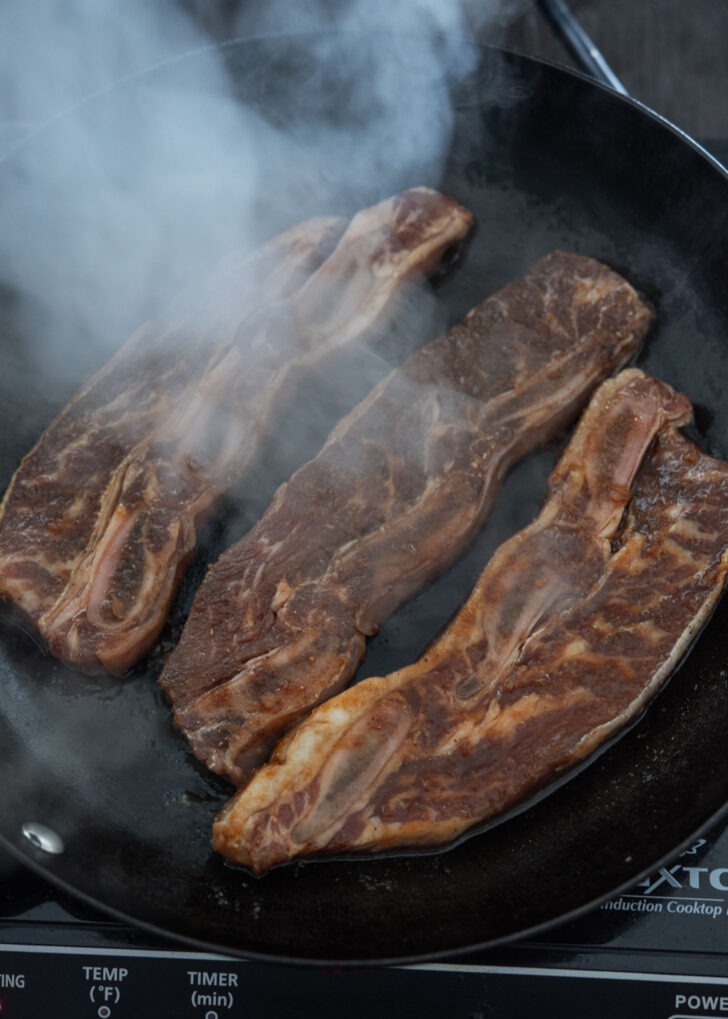
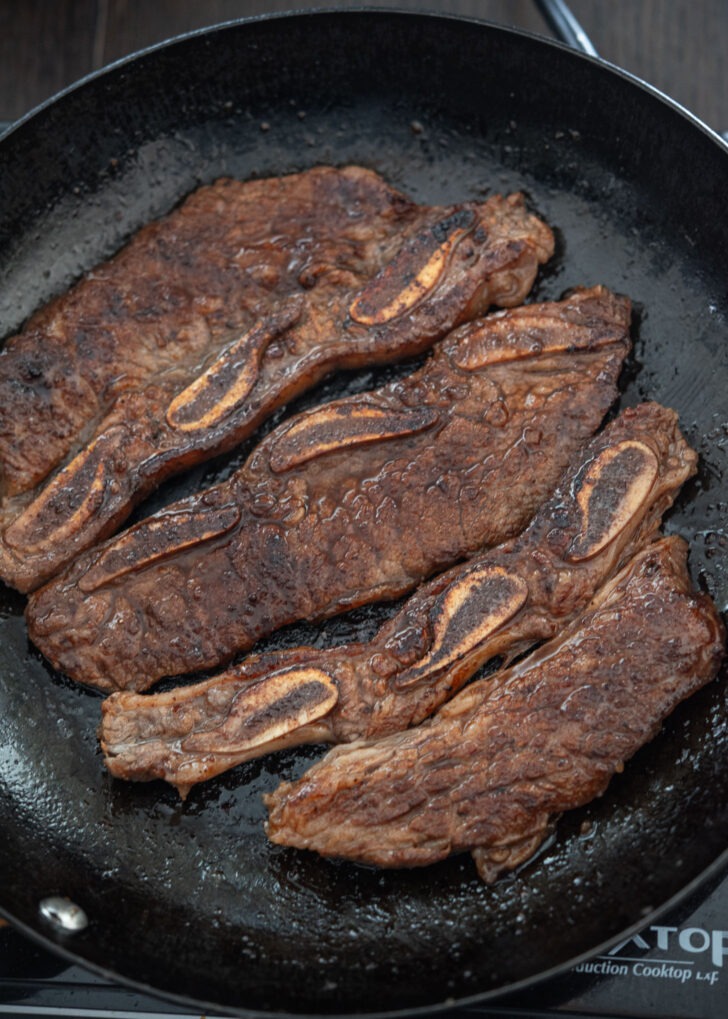
I prefer to grill outdoors over medium-high charcoal for the best flavor, but you can also broil or pan-sear them indoors. Each method gives slightly different results:
- Grilling: brings out that smoky, restaurant-style flavor.
- Broiling: easy and mess-free for apartment cooking.
- Pan-searing: quick, great for weeknights, and helps you control caramelization.
My tip: don’t crowd the pan or grill. Give the ribs a little space so the sugars caramelize instead of steaming. A few seconds too long can burn the marinade — so keep tongs in hand and watch for that deep mahogany color.
You’ll find the step-by-step directions for grilling, broiling, and pan-searing in the recipe card below.
What to Serve With Korean BBQ Short Ribs
Korean BBQ is all about balance — rich grilled meat with crisp, refreshing sides. I always serve LA galbi with a bowl of steamed white rice, plenty of Pa Muchim (Green Onion Salad).
Wrap the ribs in lettuce or perilla leaves, add a dab of Ssamjang (Korean Dipping Sauce), and you’ve got the perfect bite. If you’re hosting a BBQ party, mix in some Samgyupsal (pork belly) for variety — the combination always wins over guests.
NOTE: This recipe was originally posted in February 2014. While the recipe itself remains unchanged, I’ve updated the images and added more information to enhance the content.
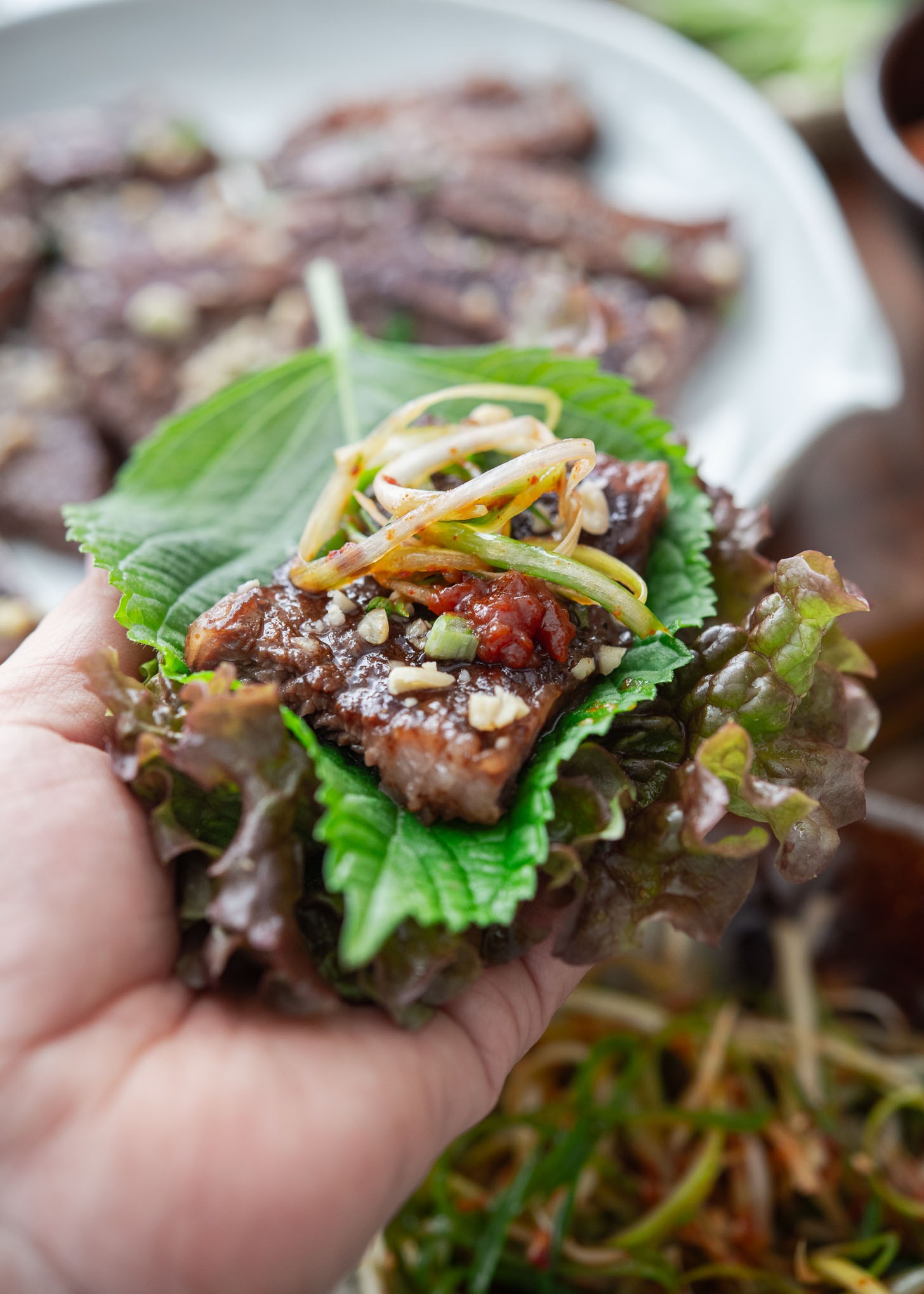
Love this recipe? Rate it and share your experience in the comments below! On Instagram? Tag me to showcase your creation. For more delicious recipes, subscribe to our newsletter!
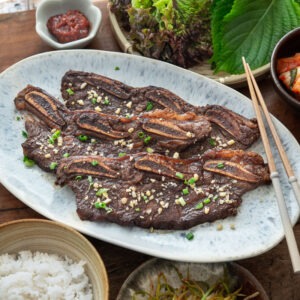
LA Galbi (Korean BBQ Short Ribs)
Recipe Video
Ingredients
- 2-1/2 lb (1.1 kg) beef short ribs, flanken cut
- 1/2 (about 100 g) large onion, diced
- 1/2 (about 120 g) large Asian pear, peeled and diced
- 1/2 (about 50 g) kiwi, peeled and diced
- 1/3 cup (80 ml) soy sauce
- 2 tbsp (30 ml) Korean soup soy sauce (gukganjang)
- 2 tbsp (25 g) brown sugar
- 1/2 tsp garlic powder
- 1 tsp (5 g) ginger paste, or 1/4 teaspoon ginger powder
- 1 tbsp (15 ml) Korean plum extract (maeshil-cheong), or sweet rice wine
- 1 tbsp (15 ml) sesame oil
- 1/4 tsp freshly grated black pepper
Instructions
First Marination
- Blend the onion, Asian pear, and kiwi in a blender or food processor until smooth. (Or finely grate them to make a smooth puree.) Pour the puree over the short ribs in a shallow dish (a 9×13-inch / 23×33 cm pan works well). Toss to coat evenly. Marinate at room temperature for 45–60 minutes or refrigerate for 2 hours.
- Remove the ribs and scrape off excess puree before moving to the next step.
Second Marination
- In a clean bowl, combine soy sauce, Korean soup soy sauce, brown sugar, garlic powder, ginger, sesame oil, and black pepper. Add the ribs and coat evenly with the second marinade.
- Cover and refrigerate for at least 4 hours, or overnight for deeper flavor. Before cooking, let the ribs sit at room temperature for 15 minutes.
How to Cook LA galbi
- Grilling: Preheat a charcoal, gas, or stovetop grill pan to medium-high heat. Grill the ribs for 2–3 minutes per side, until nicely charred. (The thin slices cook quickly — don’t overcook!)
- Broiling: Preheat the oven to broil. Arrange the ribs in a single layer on a broiler pan, about 6 inches (15 cm) from the heat. Broil for 5–6 minutes, flip, and broil another 3–4 minutes, watching closely to prevent burning.
- Pan Searing: Heat a non-stick or cast-iron pan over medium heat. Lay ribs in a single layer and cook 4–5 minutes per side. If the pan dries, add a spoonful of marinade (strain first). Cook until the sauce thickens and ribs are browned and glossy.


I’ve been using this receipe for many years now. It is beyond the best. The meat is tender and delicious. I do recommand a 100%.
Ok l, I got meatier beef short ribs, so a 3 minute sear was a non-starter. Instead I seared the ribs for 3 minutes per side, then put them back in the soy marinate and cooked them at 350 for an hour. They were fabulous. I also didn’t have pear or kiwi, so substituted shredded apple. It worked well!
OK, so another Holly recipe made off my ‘to-do’ list and it was, hands down, the BEST flanken ribs I have made. I used a regular Bosch pear and Mirin as subs. The second marinade went overnight as suggested. Seared ribs over coals in the Weber, finishing quick over indirect heat, literally minutes. The meat rested about 15 minutes as I got the rice plated. The other times I’ve tried these ribs I’ve been disappointed….NOT this time! They were delicious & we look forward to another batch.
Hi Holly, thank you for sharing your recipe! I live in LA, and I have been searching for a recipe to mimic the galbee at a well known Korean restaurant named Chosun Galbee. They have achieved the most balanced and refined marinade – not too sweet, salty
or garlicky – everything blends together in perfect harmony and elevates the meat. I haven’t tried your recipe yet, but it looks like just the recipe to achieve this mellow balance. Would this recipe work fine on the regular galbee cut that is butterflied and folded onto the bone?
It should work fine. Hope you enjoy this Galbi recipe. It really is exquisite.
hi holly,
marinating for four hours in the soy sauce is a long time. can i cut the time in half and marinate for two hours?
thanks
you can try for 2 hours, but at least 4 hours of marination will bring a better result.
Hi Holly,
Thank you for posting this recipe. I made it tonight and it was superb!! It was my first attempt and I was so happy with the results. Your pictures and technique are just beautiful. I look forward to trying more of your asian recipes. Thank you…be blessed …Sharon 🙂
Hi Sharon, I am glad to hear that. This is one recipe I cherish and it makes me happy that someone else got a great result, too. Thank you.
I’m looking for a good Kali recipe and yours sounds very good. I am wondering if you can broil or bake this in the oven? Thanks
Hi Terese, I am glad to hear that you want to try my recipe. If you want to cook this in the oven, I would recommend to broil. Hope you enjoy! Thanks.
How long would you broil for? thanks
How long would you broil it for?
I can’t wait to try this recipe as I’ve been in search of a Kalbi recipe that differs from my own. A lot of recipes call for soaking the ribs in cold water first. May I ask if you do that as well? I always worry that it will dry out the meat.
You don’t need to soak the ribs in the water for Galbi making. Soaking is good for bone-marrows or other type of braised dishes. Hope you enjoy this galbi recipe. Good luck!
If I triple the amount of meat and adjust the recipe accordingly, would it ruin the dish if I did 1.5 kiwi also (based on the ratio)? Or would that be too much kiwi?
I think 1 small kiwi will be all you need. Even though you triple the recipe, kiwi doesn’t have to be. Hope you enjoy the galbi. Happy cooking!
It looks beautiful, all the steps are clear, and sounds better than others. Every recipe asks for a 24 hour marinate, but fruits and onion and sesame oil add a lot of acid and deteriorate the meat texture in 24 hours. Great. I will try and let you know the outcome with Turkish beef.
Hello,
In the recipe instructions, you mention the optional addition of Korean corn syrup but you don’t list the quantity or purpose for this ingredient. Thanks in advance for you help and for this awesome recipe!
Hi Susan
I didn’t put Korean corn syrup in the recipe neither in the recipe instruction. Did you see it in a different recipe by chance?
Hi Holly,
In your recipe instructions, at the end of step 3, you have written “…and Korean corn syrup (if using) in a shallow pan…”. Maybe my computer is wonky or I’m imagining weird things. 🙂
Oh, I see now. I meant to write the Korean plum extract, but instead I wrote the corn syrup. My apology! Please disregard the corn syrup. No, your computer is not wonky, I think I am getting wonky with aging… haha!
Can you help me? I noticed this was categorized under gluten free. Is it really? I can buy tamari for the soy sauce. Not familiar with korean soy sauce.
Hi Lenette, Korean soy sauce for soup is made of 100% soy. I checked the label of my bottle and I don’t see any wheat product written on it. It is different that most soy sauce.
I am going to try this recipe. I would like to use fresh garlic instead of powder. Can you tell me what amount I would have to use?
Thanks!!
Hi Katherine
Of course you can use fresh garlic. I would say about 2 cloves of garlic if using fresh. Hope you like this recipe! Thanks.
This is such a rich and delicious recipe. I have wanted to make it since you posted it. I made it tonight for dinner and it is absolutely superb! I like it with rice and kimchee. My husband prefers the traditional way of eating it with doenjang on a lettuce leaf. I hope your readers try this type of galbi, it is fabulous. Thanks, as always for great recipes!
I am so glad to hear that you and your husband loved this Galbi recipe, Nancy. Thanks for your sweet comment. You are making me crave my galbi again.
Hi Holly, Thanks for stopping by my blog earlier. Fab pics and yummy recipes. My OH would love these.
You are the first Korean cook I have seen use gukgangjang with meat. For people who are gluten-free, this is their best soy option but many Korean chefs will tell them “You can only use soup soy sauce with soup. It’s too delicate for meat.” You are awesome!
I grew up in Southern California, and when I moved to New York I was shocked to discover that the galbi I’d been eating my whole life was actually not Korean, but Korean American. I’m so happy to see a food writer actually recognize L.A. galbi as a homegrown invention.
p.s. My mom has always done Asian pear and kiwi, but she uses garlic instead of onion.
Wow, it’s definitely prepared in a different way to my typical method. I’m sure to try this out. So looking forward to it! Thanks for sharing your tips, Holly!
Holly, this sounds like a great recipe, I cannot wait to try. May I ask please, what is the difference between regular soy sauce and Korean soy sauce? Do you really need both kinds?
Regular soy sauce has a little bit of sweetness but Korean soy sauce for soup (we call it gook-ganjang or chosun ganjang) has more pungent flavor and somewhat tranlucent in color. Don’t get confused with Korean regular soy sauce. Basically Koreans do use two different types of soy sauce. One is the regular kind called yangjo-ganjang and the other called the soy sauce for soup (gook-ganjang).
Refer this link to see the difference. https://www.beyondkimchee.com/korean-ingredients/
I’ve used a very similar recipe from my Korean mother-in-law for the last couple of years, but I’ve never done the two individual marinade steps (and I only had one kind of soy sauce). I always just put everything in the blender. Maybe I’ll try those two changes and see if it makes a difference! Thanks for the insight.
Wow, what a great dish! This looks wonderful — it must be so full of flavor. Thanks so much.
Hello. Thank you for your great recipes and blog. My family and I really enjoy it. I have a very big family and I am wondering if I just use four times the amount of all the ingredients if I want to marinate 10 pounds of meat.
Hi Ellen
Yes, you can use 4 times of the recipe if you want to use 10 lbs of meat. Hope your family would like it.
Holly, is this an upscale recipe? I don’t remember my grandparents using Asian pear or grating an onion… if so, it seems that the pear adds a fresher taste to the marinade?
Hi Chris
Yes, you can call it upscale recipe/ Marinading the ribs in grated onion-pear-kiwi mixture first before you add the soy sauce mixture will tenderize the meat beautifully without the fibers from the onion and the fruit, which creates the clean aftertaste. You will like this recipe.